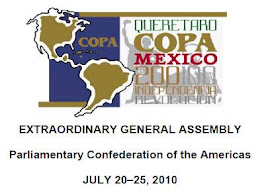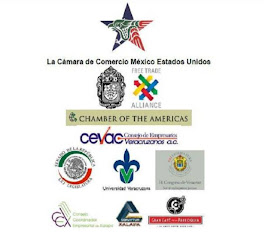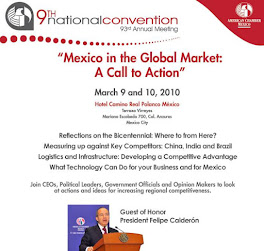
My husband and I arrived here in Vera Cruz, Mexico, the first port city on tierra firme of all of the Latin Americas, and which is still the most important port for Mexico. It is about half way down the Gulf of Mexico coastline from the border at Brownsville,Texas; quite literally the center of Mexico’s “sea life” and now also its petroleum center.
But in spite of the major development of refineries, and dredges too far away to even see from here, the City of Vera Cruz bustles with a life of one million residents, continuous modern development, national tourism, and yes, the openness of the sea that keeps the city from ever feeling crowded or ugly. In fact, after driving down the coast on the old Route 180 Highway-- with “highway” being a complete misnomer until it reaches the outskirts of the City-- Vera Cruz is a clean and bright city—a real reprieve from the otherwise heavy poverty that permeates life along most of Route 180. In fact, one of the major streets of Vera Cruz City runs along the beach, clustered with old hotels, quaint restaurants, lots of candy-colored beach umbrellas punctuating the wide beaches, a wonderful sea aquarium, vendors of all stripes and types, and bronzed bodies in family units of three to four generations, all enjoying the wonderful town and beaches. This is mostly a national tourist and vacation spot, all the more interesting for foeigners.
I am originally from Norfolk and Virginia Beach, VA, at the joining of the Chesapeake Bay and Atlantic Ocean, also coastal towns, and the one thing that I asked almost immediately is, “Well, what about jellyfish?” There are none, so bathing is safe in almost all ways, with shallow shores for a while out, no stinging sea life, and just enough white-foamed breakers to make the sea look like a sea should look. The weather has been wonderful; it is the spring break of Semana Santa, but Easter was last Sunday, so we missed all the Mardi Gras events, followed by the religious parades with statues of the Virgin and Christ, and penitents bent over their crosses. That is really too bad, because these fiestas and parades are impressive experiences, and a touch of the Catholic middle ages in a modern world.
Vera Cruz is indeed a “New World” city. It was settled by Cortes in the 16th century, who broke with King Ferdinand and Queen Isabella of Spain, sponsors of Christopher Columbus’s discoveries, and then Cortes, by refusing their orders to return to Spain, instead choosing to create the state of Vera Cruz and claim himself the Governor. His rebellion was complete when he burned his Spanish galleons, leaving no way to return to Spain. This incredible new land of Vera Cruz is no less than 745 kilometers ( approximately 462 miles) of shoreline on the Gulf of Mexico endowed with dunes, virgin coastal vegetation including pines and palms. But the beauty doesn’t end there: the mountains, originally volcanic, are sometimes as close as a half hour’s drive, where you can see pristine lagoons and rivers, vegetation of all types, including rain forests, and natural wildlife from the most melodious birds, for which Vera Cruz is a major bird-watching center, to wild monkeys. All the cities have both Spanish Colonial architecture resonating with its influence of Moorish architecture (Hotel Mocambo being an amazing example of this style), and the incredible variations of the five different Pre-Hispanic tribes of Indians native to this area, mixed with slave traditions from Africa, including words and structures resonating their native housing of round huts with straw roofs. The wonderful multicultural mix, as seen in the local people’s customs and faces, is an adventure unto itself.

The Hotel Mocambo does not have as long a history, but still finds its name rooted in that period. It is an African name--Mocambo, exotic at the time, and still so, when the Spanish language started to become integrated into the local cultures and the ones they imported with slavery when the local Indian population died out from the European diseases given to them by the Conquistadores. I personally think this is a fascinating irony: the most luxurious and aristocratic hotel built in 1938 for the rich and famous, have named their unique hotel after a word steeped in the slave culture. Maybe it has always been that way, with the rich and the poor, never truly every being able to isolate themselves one from the other, ever entwined in history and need.

Well, we came here to visit Senator Juan Fernando Perdomo, congressional representative for the State of Vera Cruz and Vice President of the Mexican branch of the Chamber of the Americas (COTA), as I am on the COTA’s Foundation Board and wanted to spend some time with him. Hotel Mocambo is Sen. Perdomo’s unofficial office outside of the capital and congressional offices in Mexico City. And I can certainly see why; what a gracious way to meet, to entertain and to just sit and enjoy an iced tea peering out over the beautiful coastline from the COTA office on the fifth floor of the hotel, where I am presently writing this article. Subtle persuasion somehow seems easier in such a beautiful and relaxed environment. How can anyone not be charmed into agreement with such a harmonious and enriching location, as well as Senator Perdomo (but that is another story altogether for another day).
To use the word “expansive” to describe this incredible architectural jewel is an understatement. Most of us who live the “normal” life, don’t know what a truly spacious hotel looks or feels like; the Hotel Mocambo has more space in gracious entries, salons, restaurants, terrrazas and verandas than in the hotel rooms themselves. The closest we modern-day tourists may come to so much luxurious space are in the expansive lobbies of today’s Hilton and similar hotels, but they mostly go up, not out. You can’t run up ten stories for your morning exercise while breathing the salt air; at the Hotel Mocambo, you can literally jog for kilometers along the expansive balconies that run along every floor of this structure, over arcades of domed sunbathing areas around the pools, meandering walkways, and bridge-like structures connecting the ever expanding number of buildings. I asked the owners how many kilometers of balconies and rooftop walkways the hotel has, and even they didn’t know. I guess you just have to come here and experience it for yourself.

When I first walked in, and around, I was struck by the image of what this hotel was in its early days. Without having read any of its history, I could immediately envision the genteel wealthy folks enjoying a sort of Titanic luxury with a Hollywood glamour enlivened by the famous movie stars and bull fighters, extremely wealthy developers and plantation owners, and yes, even the politicians of the day.
It was the ultimate place to see and been seen visiting. Juan Fernando Perdomo, our modern-day politician, helps keep part of that glamour by having political and business meetings, as well as friends, here at this grand hotel.
Did I say the hotel is expansive? How many hotels have you been in where there is more room for red-tiled terraces and balconies than actual hotel rooms?? Getting to the actual center of Vera Cruz city at the time was done by horse back on the beach. The land this hotel was built on at the time was a sand dune completely covered in sea pines and palm trees, totally isolated, and where space was not even an issue worth mentioning, other than “expansive” space. The architecture was rooted in both the colonial Spanish roots with its slight Moorish touches (by a Spanish architect from Andalucia), and the profile of the land, i.e. hotel floors, rooms and balconies terraced down toward the beach, with the dip before the dune terraced in exotic gardens. And in its day, this was a totally secluded structure, an entity unto itself, while today, I look out over huge expanses of sea, small islands out a ways (where the Indians supposedly had their ritual sacrifices and offerings of humans), and high-rise developments to my left and right as the Hotel becomes integrated in the two cities of Vera Cruz and Boca del Rio, once a distant little fishing village and now an expanding city unto itself, its traditional colonial City Hall lost in the labyrinth of cars and new buildings, a fate Vera Cruz City itself escaped in spite of its tremendous growth.

Of course the hotel is showing its age: the plumbing is inconsistent from room to room, the brilliant white washed walls are now a faded eggshell-color, and the endless iron balcony railings and terracotta roofs are showing wear and tear. But what is not lost one bit is the elegance of yesteryear. The theme of the sea is everywhere and maintained to a fine polish: finely carved woodworked doors and encasements; windows regaled of stained glass ships and sea themes—billowing sail boats, galleons, fish from the local seas; tropical flowers, both in stained glass renderings or in real life on every table with birds-of-paradise greeting you everywhere. I suppose real elegance never dies, even if weather and time have their way. But the feel of grandiosity is the Mocambo’s true inheritance to those of us who enjoy a stay, or have a business meeting or a “dream” wedding here on the endless patios and plaza-like verandas and balconies. It is forever a jewel of the Mexican Gulf coastline, which no one should miss—national Mexican or foreign tourist!






